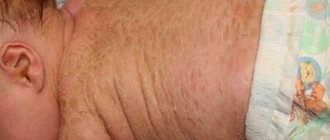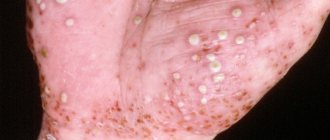November 20, 2015
Skin diseases are quite common in modern times - poor environment, stress and poor lifestyle also affect the health of the skin. However, many manifestations on the skin may not be so much an independent disease as a consequence of diseases of the internal organs. Each specific case requires an integrated approach to identify the root cause. Therefore, such branches of medicine as dermatology, dermatovenereology and general therapy work together.
Medical offers consultations with highly qualified dermatologists who will definitely help you cope with the disease and, if necessary, prescribe complex treatment together with other specialists.
What symptoms should you see a doctor urgently?
People often resort to self-diagnosis of diseases when identifying changes in the skin. The Internet is replete with articles detailing the symptoms and treatment of diseases. But there are many dangerous symptoms, if detected, you should immediately contact a specialist.
1. Rash
. The rash is a symptom of many diseases, both skin and related to other organs. Rashes can be a symptom of an allergic reaction, stress, gastrointestinal pathology, and even cancer. If the rash is brightly colored and does not go away for more than 48 hours, do not delay visiting a specialist.
2. Warts
. The appearance of warts on the skin is caused by various strains of the human papillomavirus. The virus is transmitted from person to person, so if you find papillomas or condylomas on any part of the body, you should make an appointment with a dermatologist or dermatovenerologist.
3. Peeling
. A seemingly harmless symptom can serve as a signal of a dangerous disease. If peeling skin is accompanied by prolonged itching, redness and severe dryness, it is better to consult a doctor for an accurate diagnosis and treatment. If peeling has become the skin’s response to exposure to frost, sun or wind, then we recommend that you protect your skin more carefully and use special creams.
4. Change in skin color
. A change in skin color after tanning or peeling is quite understandable, but if you find suddenly appearing spots on your body or face, this is a reason to make an appointment with a doctor. Red spots can signal an acute allergic reaction or gastrointestinal diseases, yellowing of the skin is one of the symptoms of hepatitis B and C, dark spots can indicate necrotic processes.
Why should you contact the Miracle Doctor clinic?
Leading specialists
The clinic is attended by dermatologists of the highest category, candidates of medical sciences. Some doctors have more than 20 years of experience.
A complex approach
By contacting us, you can get advice from doctors of other specialties: endocrinologist, infectious disease specialist, etc.
Hi-tech
Doctors have modern diagnostic, cosmetology and surgical equipment at their disposal.
Help for adults and children
The clinic’s dermatologists accept patients of any age with infections, metabolic disorders, food allergies, etc.
Service for discerning patients
At the Miracle Doctor clinic you will find an individual approach, a friendly atmosphere and no queues.
Convenient work schedule
You can make an appointment with a dermatologist any day of the week. The clinic operates without breaks and weekends.
TOP 5 skin diseases
Skin diseases are quite common and can appear at any age. They cause physical discomfort to a person, force them to hide the affected areas under thick clothing or use cosmetics to hide imperfections.
Fortunately, modern dermatology successfully fights skin diseases. And here are the 5 most common of them.
1. Acne.
Acne, or acne, is an inflammatory skin disease that occurs as a result of blockage of the sebaceous glands. More than 80% of the world's population is prone to acne, most of them are teenagers. The disease begins with the appearance of acne, blackheads and papules (inflammatory nodules). If you are the parent of a teenager with acne, bring him to see a doctor in order to treat the disease in time and prevent its complications, or come yourself if you suddenly encounter the disease as an adult.
2. Atopic dermatitis.
Another inflammatory skin disease is atopic dermatitis. The disease is especially common among children (10–15% in developed countries). The disease is accompanied by redness of the top layer of skin, dryness and severe itching. A complete cure of the patient is impossible, but to mitigate the course of the disease, moisturizing medicinal ointments and local immunomodulators are used. Ignoring the disease can lead to serious complications and the development of skin infections.
3. Psoriasis.
Another common disease (about 5% in developed countries) is psoriasis. This is a chronic inflammatory non-infectious disease, which is characterized by the appearance of bright pink or red plaques on different parts of the body and head. In addition, there is severe burning and itching, dry skin. If left untreated, the risk of stroke increases and internal organs such as the liver and kidneys are also affected.
4. Herpes simplex.
One of the most common viral skin diseases. Antibodies to this virus are found in 90% of people. The main symptom of herpes is blisters filled with liquid that appear in the mucous membranes, most often the lips or nose. Lack of treatment can provoke a decrease in immunity and, as a result, an increased risk of acquiring new diseases.
5. Viral warts.
A common viral skin disease caused by the papilloma virus entering human skin cells. The virus is often transmitted through everyday contact (shaking hands, using objects of the carrier) or sexually. Convex nodules called warts form at the site of virus penetration. The danger of the disease is that the virus has oncogenic strains that can lead to the development of cancer.
Fortunately, there are few such strains, but it is worth checking to eliminate risks. This is especially true for women, because HPV is the first and most important cause of cervical cancer.
Leather: features and functions
The skin is the largest human organ, with its own physiology and anatomy. The weight of an adult's skin accounts for up to 15-20% of the weight of his entire body. In every square centimeter of skin there are 6,000,000 cells, 5,000 sensory points, about 100 sweat glands and 15 sebaceous glands. On the soles of the feet the thickness of the skin reaches 5 mm, while the skin around the eyes is no thicker than 1 mm. Skin differs in color, moisture, oiliness and density not only among different people, but also among the same person at different periods of his life, as well as in different parts of his body. The skin performs several important functions. Firstly, it protects the body from mechanical influences, dirt, bacteria, harmful chemicals, ultraviolet radiation, etc. Secondly, waste products of the human body are removed through the skin. Thirdly, the skin is a sensory organ: numerous nerve endings give a person the ability to touch.
The skin consists of three layers: epidermis, dermis and subcutaneous fat.
How to treat skin diseases
Unfortunately, there is no one universal remedy for treating skin diseases. After diagnosis, the doctor prescribes treatment that is appropriate in your case. It can be:
- Healing ointments and balms (healing, anti-inflammatory, hormonal, antibacterial)
- Oral medications (antibiotics, hormonal agents, immunomodulators)
- Physiotherapy (laser, magnetic therapy)
- Cosmetic procedures (cleansing, peeling, moisturizing masks)
- Cosmeceuticals (lotions, tonics, creams, masks)
Should you prescribe treatment yourself? Everyone decides for themselves. But we still want to warn you. Of course, if you have gone a little overboard with tanning or have several inflammations on your face due to the approaching critical days, then you can do without a doctor. But when it comes to serious diseases - psoriasis, allergies, dermatitis - self-medication can lead to worsening symptoms.
Contact specialists who will help you choose effective treatment. In the “Health” network of clinics, appointments are conducted by dermatologists and dermatovenerologists. They will conduct an examination, prescribe the necessary tests and help cope with the disease.
We are waiting for you at any of our branches!
Furunculosis
Most often, the development of one boil occurs quickly, and healing occurs within a few days. However, it should be remembered that in the case of boils in the facial area, especially around the orbit, nose, upper lip and auricles, due to the specific vascularization of these areas and the close proximity of important structures of the central nervous system within the skull, serious complications can occur.
Furunculosis is a condition in which many boils occur. Numerous changes tend to coalesce and form larger tumors. These symptoms often occur in malnourished people with underlying medical conditions such as cancer or diabetes.
Treatment of boils should be carried out by a dermatologist. For a single boil, topical antiseptics and astringents are usually sufficient. Multiple boils or clustered boils should be treated with systemic antibiotics. Fusion of purulent tumors requires surgical intervention.
Causes
Ichthyosis is based on a violation of the keratinization process - hyperkeratosis, excessive keratinization with thickening of the skin.
At the same time, the skin resembles fish scales, which is why the disease got its name (Greek ichthys - fish). There are vulgar ichthyosis and sex-linked ichthyosis. Ichthyosis vulgaris is based on a violation of the synthesis of the protein filaggrin, which binds another protein, keratin, responsible for keratinization of the skin. It has been established that filaggrin synthesis is regulated by a gene located on the long arm of chromosome 1. Mutation or deletion (damage) of this gene leads to disruption of filaggrin synthesis, and, as a consequence, to pathological keratinization and ichthyosis. The disease is inherited in an autosomal dominant manner and necessarily manifests itself clinically. Sex-linked ichthyosis is caused by a deficiency of the STS enzyme, steroid sulfatase. This enzyme, which ensures moisture and elasticity of the skin, is controlled by the corresponding gene located on the X chromosome (the type of inheritance is X-linked recessive, and, as a result, in a woman who is a carrier of this gene, each daughter has a 50% chance of becoming a carrier, and each son has a 50% chance probability of having the disease). Like ichthyosis, psoriasis is a hereditary disease based on pathological changes in skin cells. These changes are caused by mutation of loci of various chromosomes. These loci have been identified and counted - their number is 9. In turn, each locus contains several genes responsible for the properties and function of the skin. A hereditary factor in the form of a deficiency of the melanin pigment underlies vitiligo. As for vitiligo and psoriasis, it is not these diseases themselves that are inherited, but a predisposition to them.
Actinomycosis
The disease is caused by the bacterium Actinomyces israeli. This microorganism can live in the human mouth without causing disease. As a result of injury to the mucous membrane, the pathogen can penetrate deeper, causing actinomycosis. The development of the disease is predisposed by inflammation of the oral cavity accompanied by tooth decay, periapical infections of the teeth, and inflammation of the gum pockets. Skin changes occur on the face and neck.
Initially, they take the form of inflammatory tumors, which then disintegrate, forming fistulas, that is, channels that emerge from the surface of the skin. In purulent discharge from fistulas, characteristic yellowish grains are found. Skin changes may be accompanied by general symptoms such as fever and flu-like symptoms. Actinomycosis can also affect the internal organs of the chest and abdominal cavity.
Diagnosis and treatment of the disease requires the mandatory participation of a dermatologist, and sometimes a surgeon. For treatment, general antibiotic therapy is prescribed. Surgical treatment is used to empty pus reservoirs and remove fistulas.
Rosacea
This is an acute inflammation of the skin and deeper tissues.
The disease can occur at any age. Skin lesions are most often localized on the face and lower extremities. The inflammatory focus of the skin is bright red, swollen, clearly demarcated from the environment, the skin is smooth and shiny. The disease is characterized by a sudden onset. Skin changes are accompanied by fever, chills and cold-like symptoms.
Rosacea
This disease can cause serious systemic disorders and should always be treated by a doctor. Without treatment, rosacea can lead to the spread of purulent infection into surrounding tissues, introducing bacteria into the bloodstream and thus causing sepsis.
The main therapeutic method for rosacea is the use of antibiotics in general. Compresses with astringents can be used locally.









